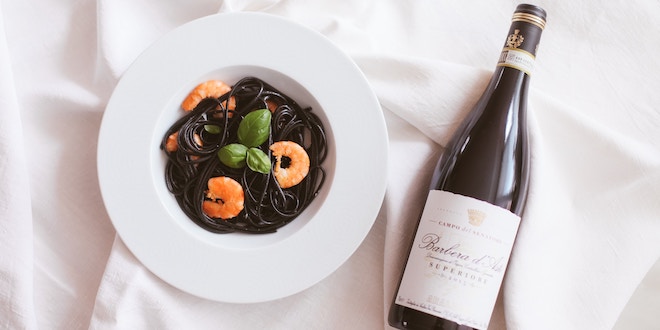Last Updated on October 4, 2023
The task of combining food with wine is simpler than you might think. Identify if the wine is light, sweet, spicy, or rich and align it with a suitable dish, keeping in mind that the general guideline is to balance the intensity of the wine with that of the food. Start viewing wine as an extra element that can boost your meal’s flavor. There are certain flavor combinations that are just perfect matches. Adding ingredients to a dish, such as butter or a dash of lemon to fish, enhances its taste; the same principle applies to wine.
The body of the wine, determined by its weight and the feel it leaves in your mouth when tasted, can range from light (or thin) to heavy, creamy, or even greasy. Like all wine traits, the perception of the body largely depends on the individual’s palate. Here are seven tips to help you out:
Align the Flavor Potency
Ensure the potency of your food’s flavor and that of your wine are in equilibrium to prevent one from dominating the other. A rich dish in flavor merits an equally vibrant and full-bodied wine. A lightly flavored dish should be complemented with a soft and invigorating Cakebread Cellars wine. For instance, robust red wines are an excellent pairing for boldly seasoned meats (such as red meats), while white wines and lighter reds go well with meats of milder intensity (like poultry and fish). Discovering the ideal blend of flavor intensity can greatly enhance your dining pleasure.
Pair the Wine With the Sauce Instead of the Meal
Concentrating on the taste of the accompanying sauce can be key in crafting an ideal food and wine combination. If the sauce is the most prominent flavor in a meal, pairing it with an appropriate wine is logical.
Take for instance, a turkey served with a creamy dressing that would pair well with an oak-aged white wine like Chardonnay or Chenin Blanc. A Cabernet Franc would be better if the same turkey is paired with a berry sauce. This principle also holds true for pasta dishes: a Sangiovese complements tomato sauce beautifully, while a Sauvignon Blanc is a fitting choice for pesto.
Ensure Your Wine Is Served at the Correct Temperature
You’ve probably heard that the vast majority of wine enthusiasts consume their wine at temperatures that are not optimal. We tend to drink our white wines too cold and our red wines too warm.
White wines unquestionably taste better when chilled, but straight from the refrigerator or, even worse, they can become overly cold after a long stint in an ice bucket. This excessive chilliness can mask the wine’s flavors, scents, and subtle characteristics. We suggest letting your white or rosé wine stand for a few minutes after removing it from the fridge or ice bucket before serving.
Red wines are often served warmer than they should be. Many wine drinkers adhere to the “room temperature” rule. This term originated before the invention of central heating and air conditioning. As a result, “room temperature” was closer to the temperature of a wine cellar, which is typically between 55 to 60 degrees Fahrenheit.
Wine Should be Sweeter
As a fundamental guideline, ensure the wine you choose is sweeter than the dish it’s paired with to achieve a successful food and wine combination. The wine may taste tart and bitter if it is less sweet than its accompanying food. This basic principle of food and wine pairing is often misunderstood or neglected, particularly due to the popular notion of ‘red wine with chocolate’.
Ensure your selected chocolate is on the bitter side and the wine is intensely fruity. Consuming a sugary cake can saturate our taste buds with sweetness, making a subsequent sip of dry wine taste flat and unpleasant. A sweeter wine can withstand the dessert’s sweetness, resulting in a more balanced pairing.
Their Weights Should Be Similar
When matching wine with food, considering the weight of both is crucial. This doesn’t necessarily equate to the intensity of flavors. For instance, a large serving of pasta with a mild sauce might be heavy in terms of weight but not in flavor strength.
Wines of a similar light style should accompany lighter and lower-fat meals. On the other hand, more substantial, satisfying dishes are best paired with full-bodied wines. For instance, a hearty casserole featuring red meat and cheese would complement a robust red wine nicely.
The wine’s weight takes precedence over its color when pairing. Even a full-bodied white wine, such as an oaked chardonnay, can work well with richer, heavier dishes. Similarly, light-bodied red and white wines pair suitably with lighter foods like poultry, fish, and salads.
Spicy Food
Wine pairings can be challenging with spicy foods due to the intensification of exotic spices and heat by high alcohol content; even beer doesn’t pair well with highly spiced dishes. Nevertheless, a light white or a mildly sweet wine can be an ideal match, especially the latter. The balanced sugar content in a mildly sweet wine usually helps to temper the spice, maintaining the wine’s authentic fruity notes while introducing a refreshing element to your mealtime.
Do Not Mix Salt and Tannins
Salty dishes pair well with light, refreshing wines that balance their robust flavors. Wines with a hint of sweetness can further elevate the taste profile of these salty foods. However, pairing salty foods with wines high in tannins should be avoided. The interaction between salt and tannins results in an unpleasant, harsh taste, leaving your mouth dry and bitter.
Both salt and tannin induce a similar reaction in your mouth, causing your gums to pucker and giving you a dry sensation. When a lighter, more rejuvenating wine is paired with salty foods, your mouth feels refreshed and cleansed, ready to savor the next morsel.
Endnote
The principles of pairing food and wine are simple to understand and can be easily incorporated into your everyday life after going through this guide. The wine matching chart we provide and the rules and principles of wine pairing we discuss are merely the beginning. As you become proficient in the basics of wine pairing, continue to experiment and explore to find what suits your tastes best. This exploration will lead you to discover your own perfect harmony of tasting experiences.
You may also like:
10 Most Popular Cheese Dishes in the World
 Travel for Food Hub The Food Blog for Travel Lovers
Travel for Food Hub The Food Blog for Travel Lovers
















